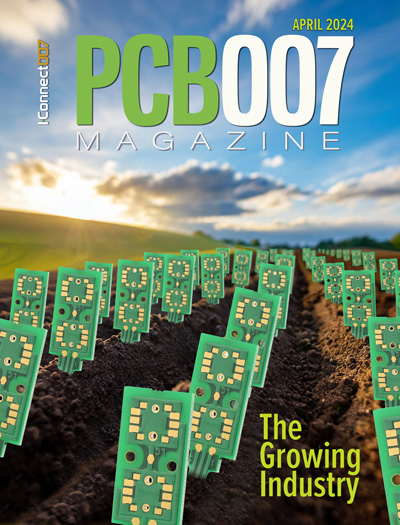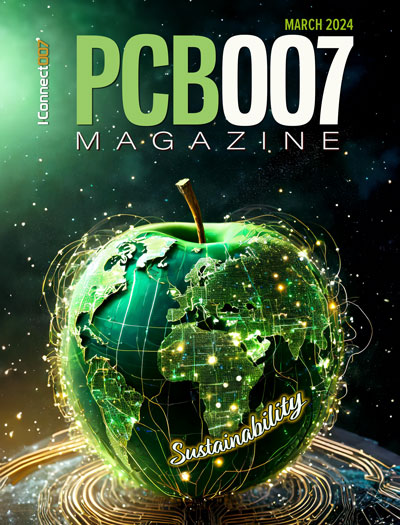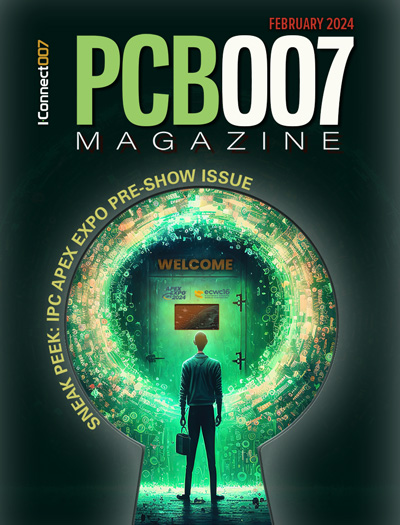-

- News
- Books
Featured Books
- pcb007 Magazine
Latest Issues
Current Issue
The Growing Industry
In this issue of PCB007 Magazine, we talk with leading economic experts, advocacy specialists in Washington, D.C., and PCB company leadership to get a well-rounded picture of what’s happening in the industry today. Don’t miss it.

The Sustainability Issue
Sustainability is one of the most widely used terms in business today, especially for electronics and manufacturing but what does it mean to you? We explore the environmental, business, and economic impacts.

The Fabricator’s Guide to IPC APEX EXPO
This issue previews many of the important events taking place at this year's show and highlights some changes and opportunities. So, buckle up. We are counting down to IPC APEX EXPO 2024.
- Articles
- Columns
Search Console
- Links
- Events
||| MENU - pcb007 Magazine
Heading Into 2020 With Isola
January 6, 2020 | Barry Matties, I-Connect007Estimated reading time: 16 minutes
I recently spoke with Isola’s Travis Kelly, who has moved from acting CEO into the position of president and CEO. Chief Sales and Marketing Officer Sean Mirshafiei also joins the conversation as they share an update on the progress on the company’s new Arizona factory, as well as their views on the markets and technology trends.
Barry Matties: Travis, the last time we spoke, you were in a temporary leadership position; now, you are the CEO.
Travis Kelly: That’s correct. I was the executive vice-chairman of Isola and acting CEO. Now, I have fully stepped into the role of president and CEO, as well as executive vice-chair of Isola.
Matties: You were also, at that point, selling off some assets and creating some new infrastructure in Chandler, Arizona.
Kelly: Isola has been based in Chandler, Arizona, for the past several years. We ended up selling one of our production facilities in Chandler and built a new global headquarters, bringing together all our North American corporate employees and the R&D team, including a world-class research lab, under one roof. The new facility will also include a state-of-the-art quick-turnaround (QTA) operation and enable more collaboration by having everyone under the same roof.
Matties: And the core strategy there was quick turnaround so that you could create a flexible manufacturing environment and serve the market needs better.
Kelly: We are experiencing a lot of shorter runs and a higher mix of products, and this facility is going to help facilitate the need of our customers to get to market quicker. A lot of the focus will be on providing material that our customers need for prototyping and qualifying. When our customers need to set up a new design and have material there immediately, we can turn that around extremely quickly.
Matties: And we know delivery has been an issue for materials, especially in the RF sector with high-end material. Previously, I talked to Jeff Waters, the previous CEO, and he shared that Isola had been a little slow to the game in some of the marketplace. How have you adjusted that, and where are you at on the product offering?
Kelly: In the past, there were technology cycles in which Isola did not participate. Now, with the processes and controls we put in place—especially within our R&D and engineering departments—we have been able to condense and crash the timing of getting new products to market. On top of that, we are making sure that we have the controls and processes in place to ensure our products will perform better than our customers’ expectations so that when we launch new products, they can be mass-produced and are ready to be launched into the production environment. Therefore, we will have a quicker time to market as well as more controls around the products that are being launched.
Matties: Sean, tell us about your role in the organization.
Sean Mirshafiei: I’m responsible for global sales and marketing. In our business, sales and marketing are the most customer-facing elements. Our intention is to make sure that we, on the one hand, promote our materials to specific targeted markets, while at the same time using product promotion and engagement with customers to identify unmet needs for future product developments.
Matties: When you look at the marketplace, what areas are thriving right now? I know there are some slowdowns in areas, but tell us what you see for market conditions.
Mirshafiei: Market segments that enable 5G technology are thriving now. These segments include both antennas as well as the mobile backhaul infrastructure. For Isola to be successful, we have to focus rather than try to serve everyone’s needs. Wired infrastructure investments that underpin 5G technology are one example of a focus area. That’s a segment where we’ve had a long history of being a technology leader, and it’s important to be a key supplier. We’re in the midst of finishing the development of an innovative product that’s going to support 400-gigabit-per-second technology. We believe this will be a key product for us in 2020, and we are already working with some of the leading OEMs to validate the performance.
Matties: On the consumer side, we all hear about 5G and the impact that it’s going to have. You’re touching on some of the technology, but when we start thinking about autonomous cars and the ability to move data at those rates, is that an enabler for a lot of new opportunities and product development?
Mirshafiei: Autonomous vehicles will integrate with 5G networks at some point. The current advanced driver assist systems utilize radar in addition to other sensing technologies. That has obviously been an area for growth, as safety systems have become a key selling trait for vehicles in the past few years. We’ve been developing products intended for RF/microwave applications for a number of years, and we’re very close to having our first very high-volume application for our Astra MT7 in long-distance radar. We expect to see that program launch in high volume in early 2020.
In addition to safety and autonomous vehicles, you raise a good point about automotive. Not only are we seeing autonomous vehicles, advanced driver assistance, and the integration of 5G networks, but we’re also seeing electrification as an emerging technical challenge. We developed IS550H in a German consortium with the intention of replacing ceramic circuit boards and upgrading the capabilities of cars. High-speed digital, RF/microwave, and automotive applications are the three legs of the stool that a lot of OEMs and PCB fabricators are seeing interest in. And for us, we need to be successful in these segments.
Matties: As you start talking about voltage and these harsh applications, you also have to deal with thermal issues. What impact does that have on the materials that you’re bringing out?
Mirshafiei: With higher voltage and more severe environments, these materials have to be more thermally robust. We’ve had the insight from the market that has allowed us to incorporate that into these materials. For example, the IS550H is not only suitable for electrification but also capable of addressing more extreme thermal requirements.
Matties: We’re dealing with the potential of human fatality if there is product failure in these applications.
Mirshafiei: To be able to bring value to the market, we cannot just participate on a transactional basis. What we really need to do is to work alongside the PCB manufacturers and the Tier 1s to truly understand what that need is and what material attributes influence the technical requirements. If we’re part of that process, helping to validate what the need is, we’re going to be in a stronger position to be able to support it.
Matties: Any time you integrate yourself into somebody’s process, you’re selling material, but when you understand their process in a holistic form, you have an advantage.
Kelly: And we have spent a lot of time doing that with Sean and his OEM marketing team. It is imperative that Isola understands our customers' processes. How do we assist customers through the entire supply chain to make sure that we’re developing the products that they need? Regardless of whether it’s automotive, aerospace, or defense, we develop products to solve problems for our customers. And Isola’s products are a critical part of the value stream. When you really think about what Isola produces —whether it’s the dependability of a ground-to-air missile, fighter jets, automotive, etc. —it’s imperative that our products work.Page 1 of 2


